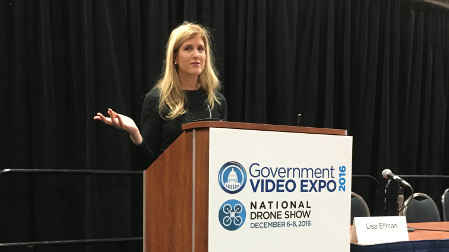GV Expo: Moving Drone Regulation Forward Through Education
WASHINGTON–Drone technology “has moved forward so quickly that what used to be considered toys are now tools,” said Lisa Ellman, a partner in the law firm of Hogan Lovells, and recognized as one of the "world's foremost authorities on drones and law." She addressed attendees on day two of the National Drone Show about the rise of drones in media production.

“[Drones] can film movies, provide security, respond to disasters and even entertain a crowd. I was actually just down in Orlando where Disney just launched its fireworks drone show.”
For journalists and newsgatherers in small markets, drones can provide aerial coverage for stations that otherwise can’t afford a helicopter. For larger markets they provide huge public safety benefits. And it’s the consumer who wins through better information, received more quickly with incredible, engaging images, she said.
What has really caught the attention of policy makers is the economic potential for the drone industry and its ability to bring jobs here to the United States. Estimates vary on total drone use, Ellman said, but a lot of big numbers are being tossed around. “A recent Pricewaterhouse Coopers report estimated that the global value of drone-powered solutions would be over $127 billion.”
Even given all the economic benefits to the use of drones, policy makers are focused on the safety, privacy and security implications for drones.
EDUCATING POLICY MAKERS
“It’s been a very exciting time for this industry, but it’s also been a time of education and educating policy makers. The technology can move right along, but if we don’t have the right policies in place we’re not going to be able to properly enable it," Ellman said. “The U.S. has, frankly, struggled a little bit responding to this growth in the emergence of this technology. Japan, the United Kingdom, Australia, New Zealand and China are way ahead of us in terms of allowances and regulations. But we’ve made substantial progress and [educating policy makers] is where we need to play a critical role.”
In 2012 Congress mandated that we incorporate drones into our national airspace. The FAA had been working on this for many years, but the rest of the federal government began to pay attention at that point.
“How do we balance the economic opportunities of this amazing emerging technology with national security and safe airspace operations? How can we do that safely and securely?”
There’s been a lot of activity, not just at the FAA, but across the federal government concentrated on moving drone innovation forward. On August 2, the White House Office of Science and Technology Policy (OSTP) hosted a symposium centered on policy on drones, bringing public agencies and private industry to the table to discuss drone innovation and how they can tackle policy issues together. While there is uncertainty ahead, it is hoped that the Trump administration will keep this momentum moving forward.
THE PUBLIC'S UNDERSTANDING OF POLICY
Along with federal regulations, drone users must pay attention to state and local ordinances as well. State laws generally focus on privacy issues because drones have captured the imagination of the American public. Over the last few years there have been hundreds of state and local bills implemented that would limit drone use in communities. In 2015, 45 states considered 168 pieces of drone regulatory legislation. In 2016, those numbers so far are 38 states and 100 pieces of legislation.
A recent poll asked Americans whether they were concerned with privacy or safety with the use of drones. The poll showed that 59 percent were concerned about privacy issues, while safety was an issue for 40 percent of the participants.
The FAA is just now becoming educated about drone technology. Under federal aviation regulations, drones are considered aircraft so all aviation regulations apply, which has created a lot of bureaucratic hoops to jump through in order to be able to operate.
Drone users fall into three categories: the hobbyist (flying only for recreational purposes), the public agency or entity and the civil user, which includes commercial use. The regulations you have to follow depend on which category you fall under. If you are a civil/commercial user who plans to sell or make money on your drone footage you must follow FAA regulation Part 107, which governs civil use of drones with regards to registration, licensing and drone usage. (See www.faa.gov for more information.)
A number of broadcasters have asked Ellman about whether or not it is legal to use photos or footage in their news broadcasts that originated from a hobbyist. A ruling by the FAA is based on the “original intent” of the hobbyist. If he or she took the footage without the intent to make money on it, then the usage is permitted.
While hobbyists do have a number of rules to follow, the rules for commercial users get more complicated. The new Small UAS Rule went into effect on Aug. 29. See the Summary of Small Unmanned Aircraft Rule (Part 107).
Just before the new rules went into effect the Office of Information and Regulatory Affairs at the White House, OSTP and Office of Management and Budget heard from stakeholders that they want the opportunity to prove the safety case. They want the ability to fly beyond the visual line of sight and fly over people if they can prove they have an effective level of safety. The case was made to the FAA and in the final release of the rule a Part 107 Waiver process was included. Operating from a moving vehicle or flying over people would be an example for a waiver request, and many requests for waivers have involved night-time flying.
An obvious concern for many in the media production community is having the ability to fly over people, which is not permitted even if the people have consented to the operation. This limits flying over urban areas, directly affecting newsgatherers.
SOME GRAY AREAS
A new ruling that was recently issued concerning the Section 333 exemption will be news to most drone users. Section 333 of the FAA Modernization and Reform Act of 2012 grants the Secretary of Transportation the authority to determine whether an airworthiness certificate is required for a UAS to operate safely in the National Airspace System. About 5,000 Section 333 exemptions have been granted since September of 2014, some for closed-set filming. In a closed-set environment all participants (actors, extras, film crew, etc.) have already signed consent forms to be filmed.
According to Ellman, with no announcement, the FAA just revoked that exemption ability. On Nov. 14 the FAA posted a blanket amendment that essentially applies to all 333 exemptions already approved. Most exemptions can be implemented now through Part 107. “The only people really concerned about the 333 exemption at this point are those operating under closed-set situations,” said Ellman. “This appears to be, symbolically, a step backwards.”
Ellman touched on privacy issues with respect to private property and surveillance. A recent University of Oklahoma study came up with some interesting results. Drone cameras seem to garner a higher percentage of opposition over ground cameras when it comes to surveillance. When monitoring streets and businesses, 24 percent opposed ground cameras while 46 percent opposed drone usage. When asked about enforcing traffic laws, 34 percent opposed ground cameras, compared to 53 percent opposed to drones.
The last issue concerning privacy that Ellman discussed was related to airspace ownership. Airspace ownership is currently being considered down in Kentucky. The case of a citizen who shot a drone out of the sky over his property is raising some interesting points.
“[An important way] we can help move this industry forward is related to the issue of who owns the airspace over private property.” The precedent set was the 1946 case of the United States Government v. Causby, where the government flew a variety of aircraft as low as 83 feet over a family’s chicken farm, killing the chickens. The United States Supreme Court ruled that the aircraft was trespassing since it was flying within the immediate reaches of the soil.
In closing Ellman noted that the FAA does not have the resources to enforce all the regulations in place, but they will with respect to safety. For the most part they rely on the state and local governments enforce local regulations.
Get the TV Tech Newsletter
The professional video industry's #1 source for news, trends and product and tech information. Sign up below.
